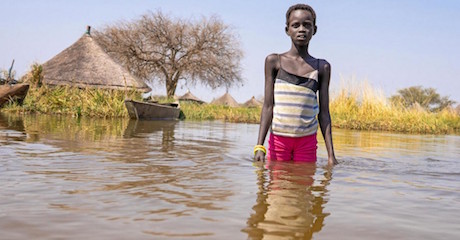As the COP27 climate conference gets underway in Sharm el Sheikh, Egypt, UNICEF is sounding the alarm: this year has brought devastating flooding to 27.7 million children in 27 countries worldwide.
A vast majority of the children affected by floods this year are among the most vulnerable, at high risk from a multitude of threats including death by drowning, disease outbreaks, lack of safe drinking water, malnutrition, disruption of learning and violence.
The climate crisis is here
“We are seeing unprecedented levels of flooding all around the world this year, and with it, an explosion in threats to children,” said Paloma Escudero, head of the UNICEF delegation for COP27.
“The climate crisis is here. In many places, the flooding is the worst it has been in a generation, or several. Our children are already suffering at a scale their parents never did.”
Pakistan
© UNICEF/UN0730485/Bashi
The aftermath of floods is often more deadly for children than the extreme weather events that caused the flooding. In 2022, floods have contributed to the increased spread of major killers of children, such as malnutrition, malaria, cholera and diarrhea.
This year’s record-breaking floods in Pakistan have left 11 million children in need of immediate assistance. The floods have contaminated drinking water, leading to disease outbreaks that compound already acute malnutrition. Estimates suggest close to 1.6 million children living in flood areas could be suffering from severe acute malnutrition (SAM). Above, children make their way home through contaminated floodwater in Jacobabad, Sindh Province, Pakistan, on Nov. 3, 2022.
Malawi
© UNICEF/UN0583677/
In January 2022, Tropical Storm Ana’s torrential rains caused major flooding in Malawi, including Chikwawa district in the Southern Region, above. Extensive damage to water and sanitation systems created the perfect conditions for a cholera outbreak that has claimed the lives of 203 people, 28 of them children. To date, 1,631 children have been diagnosed with cholera, an acute diarrheal illness caused by drinking contaminated water.
Bangladesh
© UNICEF/UN0660364/Mukut
Flooding damages and destroys school buildings, interrupting children’s education and threatening their future. In May and June 2022, 7.2 million people — including 3.5 million children — were swamped by one of the worst floods in northeastern Bangladesh in 122 years. Above, a boy spreads his soaked school books, salvaged from his flooded house, out to dry on a patch of high ground in Sylhet district in June.
South Sudan
© UNICEF/UN0594302/Naftalin
Torrential rains and flooding in 9 out of 10 states in South Sudan have forced people into temporary camps where they are living in limbo, unsure if or when they will be able to return home. Over 900,000 people have been directly impacted — half are children. “We are not a statistic in a report,” said Hans, a climate activist from South Sudan. “We are people, living in a crisis we did not create.” Above, a girl looks out over submerged houses in Panyagor, Twic East, Jonglei State, South Sudan.
Nigeria
© UNICEF/UN0722934/Esiebo
Since September 2022, NIgeria’s worst flooding in a decade has displaced an estimated 1.4 million people. Children living in makeshift displacement sites lack access to basic facilities and are in danger of becoming separated from their families and experiencing gender-based violence. Above, Akpoebi Germany, far left, and his children rigged up a makeshift wooden walkway to cross the flooded yard outside their home in Sagbama, Bayelsa State, Nigeria.
Children need climate action now
As climate-related emergencies become more frequent and more deadly, UNICEF is working to strengthen the resilience of communities and health infrastructure to withstand disaster-related hazards, and increasingly linking humanitarian response efforts with longer-term climate adaptation.
Today’s political decisions are leading to a world of global warming that is becoming unliveable for billions of people. COP27 provides an opportunity to chart a credible road map with clear milestones for finance for climate adaptation and solutions for damage and loss, said Escudero.
“These rolling disasters are straining the ability of governments and the international community to respond at the enormous scale needed,” she said. “Young people from the most affected areas on earth are drowning in climate inaction. Enough is enough. Lives are on the line — children need action now.”
Top photo: Twelve-year-old Alekiir washes pots in flood water outside the village of Panyagor in Twic East, Jonglei State, South Sudan. “I often feel sick because of the flood water,” she said. “There’s been so much disease around here.” © UNICEF/UN0594312/Naftalin
